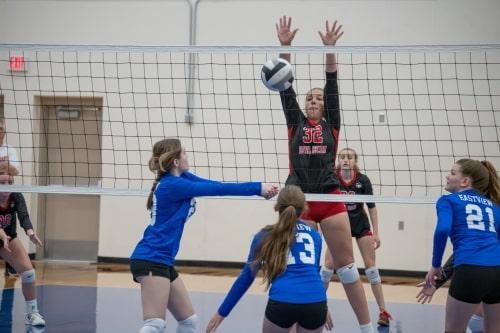Essential 6 on 6 Volleyball Drills for Team Success

As a fast paced sport, volleyball demands teamwork, strategy and technical skills. One of the most effective ways to develop these elements is through 6 on 6 drills, which simulate real game situations and help players improve their coordination and execution under pressure. Here are eight essential 6 on 6 volleyball drills designed to enhance team performance.
Scrimmage with Focused Goals
Objective: Simulate a real game while focusing on specific team goals.
Setup: Divide players into two teams of six. Play a standard game, but with additional focus on a particular skill or strategy.
Execution:
| Steps | Description |
|---|---|
| Start with a serve and play out the point | Begin the drill with a serve from one team and play out the rally |
| Focus on specific aspects | Emphasize elements like serves, receiving, setting, attacking, blocking, or defense |
| Example requirement: three consecutive passes before attacking | This encourages ball control and strategic play before executing an attack |
Benefits: This drill helps players practice in game situations, enhances their understanding of team strategies and builds overall game readiness.
Serve and Serve Receive
Objective: Improve serving accuracy and reception quality.
Setup: Six players on each side, with one team serving and the other receiving.
Execution:
| Steps | Description |
|---|---|
| One player serves | The serving team initiates the drill with a serve |
| Receiving team responds | The receiving team makes a clean pass to the setter |
| Setup and attack | The setter sets up an attack and the drill continues normally |
Benefits: This drill focuses on two critical aspects of volleyball: serving and serve reception. It helps players develop better serving techniques and improve their first contact, setting up more effective offensive plays.
King/Queen of the Court
Objective: Foster competitive spirit and improve team dynamics under pressure.
Setup: Use one half of the court, with one team (the “kings/queens”) starting on the side closest to the net and the challenging team on the other side.
Execution:
| Steps | Description |
|---|---|
| Serve from challenging team | Challenging team starts with a serve |
| Rally play | Teams play out the rally, with the winner staying on the “king/queen” side |
| Rotation | Losing team rotates off and a new team challenges |
| Scoring | Teams score points for each rally won while on the “king/queen” side |
Benefits: This drill creates a competitive environment, encouraging teams to fight for every point. It also provides continuous play, improving endurance and strategic thinking under pressure.
Controlled Scrimmage
Objective: Focus on specific game scenarios and strategies.
Setup: Play a normal 6 on 6 game but with pre-determined scenarios or rules.
Execution:
| Scenarios | Description |
|---|---|
| Starting with a free ball | Each point begins with a free ball given to one team |
| Focusing on out of system plays | Emphasize handling plays that are not ideally set up |
| Simulating end of game pressure situations | Play with tight score conditions to practice handling pressure |
Benefits: This drill allows teams to practice specific situations they might encounter in real matches, helping them to stay composed and execute their strategies effectively.
Transition Drill
Objective: Improve quick transitions between defense and offense.
Setup: Teams start in a defensive formation with a coach or extra player hitting a ball at them.
Execution:
| Steps | Description |
|---|---|
| Defensive response | Defensive team digs or blocks the ball |
| Transition to offense | Quick transition into an offensive play |
| Reset and repeat | Return to defensive position for the next ball |
| Duration | Continue for a set number of repetitions or time |
Benefits: This drill enhances the team’s ability to switch rapidly from defense to offense, a crucial skill in maintaining momentum and capitalizing on defensive stops.
Serve and Rotate
Objective: Ensure all players practice serving under pressure and rotating positions.
Setup: Normal 6 on 6 setup with a focus on serving and rotating through positions.
Execution:
| Steps | Description |
|---|---|
| Serve to initiate rally | Each serve starts a rally |
| Rotation | Players rotate to the next position after each serve |
| Continuous play | Next player serves and play continues |
Benefits: This drill ensures that all players get equal practice serving and playing in every court position, promoting versatility and readiness for game situations.
Back Row Attack Drill
Objective: Enhance the effectiveness of back row attacks.
Setup: Normal 6 on 6 game with a focus on back row attacks.
Execution:
| Steps | Description |
|---|---|
| Restriction on front row attacks | Only back row players can attack the ball during this drill |
| Setter’s role | Setters deliver accurate sets to the back row |
| Normal gameplay | Continue gameplay with emphasis on utilizing back row attacks |
Benefits: This drill helps teams develop a well rounded offense by incorporating back row attacks, making it harder for opponents to predict and defend against attacks.
Pressure Serving Drill
Objective: Improve serving under pressure.
Setup: Normal 6 on 6 setup with specific focus on serving.
Execution:
| Steps | Description |
|---|---|
| Serving goal | Each server must complete a set number of serves in a row |
| Consequence for failure | If a server fails, they go to the back of the line |
| Continuation | Drill continues until each player completes their serving goal |
Benefits: This drill helps players develop consistency and mental toughness when serving, which is critical during high pressure situations in actual matches.
Conclusion
6 on 6 volleyball drills are vital for developing team cohesion, enhancing individual skills and preparing players for the realities of competitive play. By incorporating these drills into regular practice, coaches can create a comprehensive training regimen that addresses all facets of the game.
From improving serving and serve reception to mastering quick transitions and competitive gameplay, these drills provide the foundation for building a successful volleyball team.


